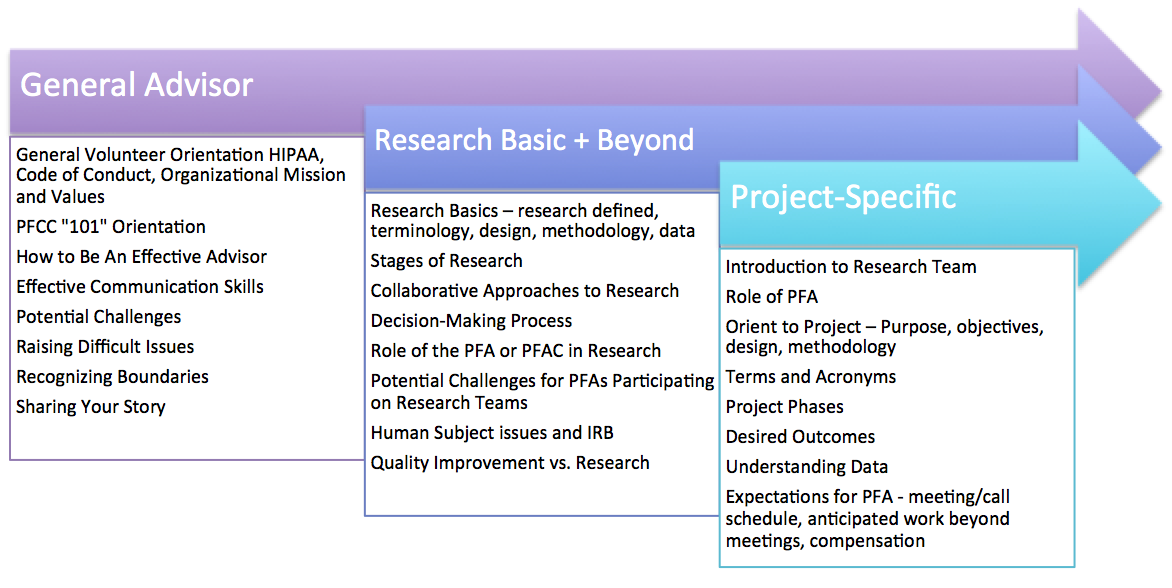Watch
Watch Christine Norton, patient investigator at HealthPartners Institute, reflect on the importance of preparing everyone for research partnerships. You can view a slide presentation from HealthPartners on the topic.
Preparing for Research Partnerships

Watch
Watch Christine Norton, patient investigator at HealthPartners Institute, reflect on the importance of preparing everyone for research partnerships. You can view a slide presentation from HealthPartners on the topic.
A core component of the project, “Creating Sustainable Partnerships with Patients and Families in Research,” was to develop and deliver training for PFACs and for researchers at each of the seven project sites. The IPFCC team created the training based on its experience over many years, interviews of program leads who are exemplars in research partnerships, and findings from key literature. We learned from the seven project sites as well. After each training, our team debriefed and revised training based on feedback provided by the participants in the training.
Patient and Family Advisor Training. There are three general components of training relevant for partnerships for PFAs and PFACs:

If you are an experienced patient and family advisor you are most likely ready to collaborate with researchers. The training received during your onboarding and orientation process as a PFA gives you a perfect foundation. Staff liaisons and chairs of PFACs can review the General Advisor topics listed above to make sure that they are covered in the organization’s PFA orientation and training.
Additional training for research is very dependent on the role the PFAC or PFA will play in a project. Most PFAs report that they want just enough information about research or a particular topic to participate fully in discussions but not so much to be overwhelmed. PFAs mainly want to understand where their input and perspectives will be needed to inform a research project.
In this project, after basic orientation to research, the seven project teams were eager to get started on a research project. After becoming familiar with the process, they were able to self-determine further training needs.
Two topics stand out as being important to cover prior to collaboration:
Decision-Making
The research process needs to be transparent to PFAs. Researchers can best address this at the beginning by clarifying the decisions and processes that PFAs may inform and those that are restricted because of research protocols. Remember that research partnerships should start early in a research project so that PFAS can collaborate at the critical planning stage.
QI vs. Research
By definition, research projects involve a question or hypothesis that is investigated to advance a body of knowledge about a particular subject with or without direct benefit to those participating in the study. Quality improvement projects aim to improve care, outcomes, and/or a process within an organization and with direct benefit to those served. (Source: American Nurse Today)
Quality improvement is flexible, continuous, and can involve planning and testing multiple changes. Research projects once designed and approved adhere to a strict protocol. PFAs who are experienced at suggesting changes and helping implement them may get frustrated with the limitations of the research process unless they understand how research is different.

Clear explanations of the difference between QI and research to PFA are found in these helpful resources:
What’s the Difference Between QI and Research Video (Institute for Healthcare Improvement)
Quality Improvement vs. Research Website (Children’s Hospital of Philadelphia Research Institute)
Researcher Training. If you are a researcher wanting to partner with PFACs or individual PFAs, you may first want to find out as much as you can about the Patient and Family Advisory program at your affiliated organization. Request a meeting with the staff liaison and the chair of the PFAC to get to know more about advisors and the impact they have had on the organization. Find out what orientation and ongoing training PFAs have received. Ask how meetings are run and how project planning is done and decisions made.
After this, researchers can best prepare for partnerships by learning about:
More information can be found in the Nurturing and Sustaining section of the Toolbox.
Determining Training Needs. As stated before, you have to tailor the training to the type and purpose of the partnership.
Highlight from the Field: Children's Hospital of Philadelphia
The Children’s Hospital of Philadelphia is developing online training modules that prepare Research Family Partners (parents and teens) to contribute as equal members of research teams. Training module development has involved conducting youth focus groups and parent interviews as well as a literature review. The training modules will address variations in cognitive capacities by creating teen training oriented toward peer social interactions, active learning, and gamification and parent training oriented toward accessible reading materials and audio learning options. A pilot of the training modules is planned for fall 2017 with a public release (and posting to this site) soon thereafter. The next phase will involve the development of training modules for researchers including the completion of trainings on partnership principles and strategies, documentation of partnership activities, and participation in partnership evaluation and improvement efforts.